2022 FORD MAVERICK traction control
[x] Cancel search: traction controlPage 331 of 533
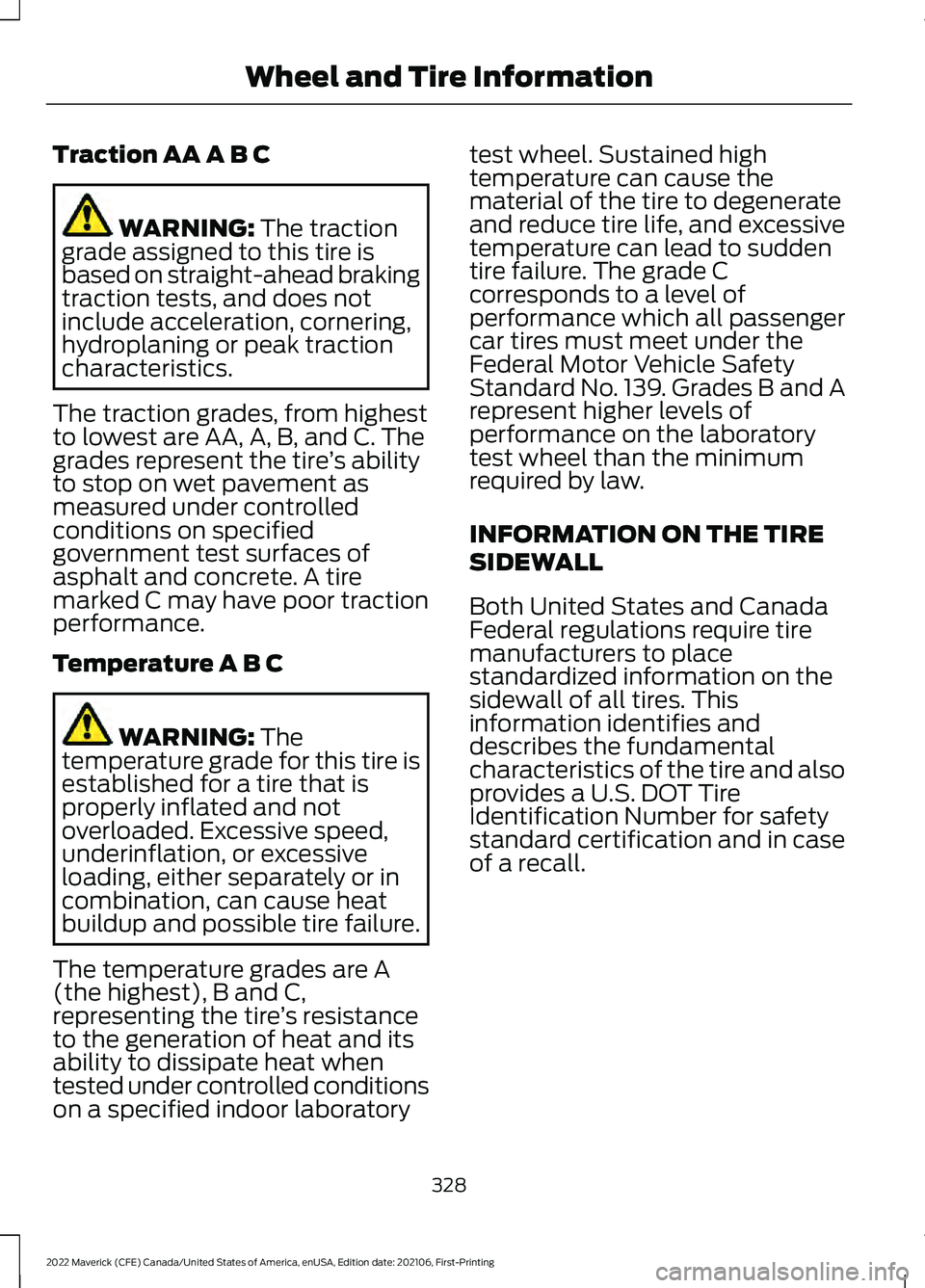
Traction AA A B C
WARNING: The traction
grade assigned to this tire is
based on straight-ahead braking
traction tests, and does not
include acceleration, cornering,
hydroplaning or peak traction
characteristics.
The traction grades, from highest
to lowest are AA, A, B, and C. The
grades represent the tire ’s ability
to stop on wet pavement as
measured under controlled
conditions on specified
government test surfaces of
asphalt and concrete. A tire
marked C may have poor traction
performance.
Temperature A B C WARNING:
The
temperature grade for this tire is
established for a tire that is
properly inflated and not
overloaded. Excessive speed,
underinflation, or excessive
loading, either separately or in
combination, can cause heat
buildup and possible tire failure.
The temperature grades are A
(the highest), B and C,
representing the tire ’s resistance
to the generation of heat and its
ability to dissipate heat when
tested under controlled conditions
on a specified indoor laboratory test wheel. Sustained high
temperature can cause the
material of the tire to degenerate
and reduce tire life, and excessive
temperature can lead to sudden
tire failure. The grade C
corresponds to a level of
performance which all passenger
car tires must meet under the
Federal Motor Vehicle Safety
Standard No. 139. Grades B and A
represent higher levels of
performance on the laboratory
test wheel than the minimum
required by law.
INFORMATION ON THE TIRE
SIDEWALL
Both United States and Canada
Federal regulations require tire
manufacturers to place
standardized information on the
sidewall of all tires. This
information identifies and
describes the fundamental
characteristics of the tire and also
provides a U.S. DOT Tire
Identification Number for safety
standard certification and in case
of a recall.
328
2022 Maverick (CFE) Canada/United States of America, enUSA, Edition date: 202106, First-Printing Wheel and Tire Information
Page 334 of 533
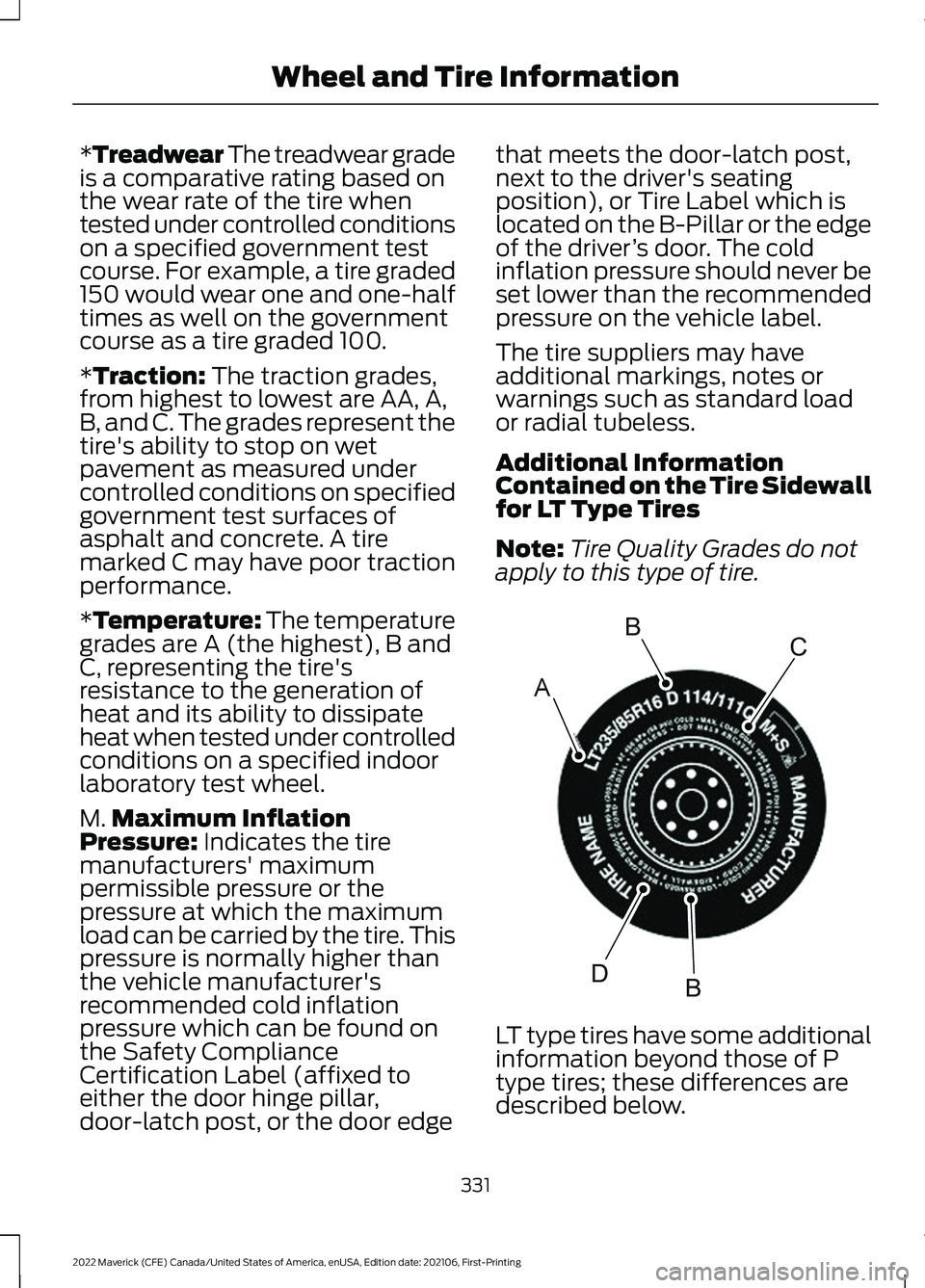
*Treadwear The treadwear grade
is a comparative rating based on
the wear rate of the tire when
tested under controlled conditions
on a specified government test
course. For example, a tire graded
150 would wear one and one-half
times as well on the government
course as a tire graded 100.
*Traction: The traction grades,
from highest to lowest are AA, A,
B, and C. The grades represent the
tire's ability to stop on wet
pavement as measured under
controlled conditions on specified
government test surfaces of
asphalt and concrete. A tire
marked C may have poor traction
performance.
*
Temperature: The temperature
grades are A (the highest), B and
C, representing the tire's
resistance to the generation of
heat and its ability to dissipate
heat when tested under controlled
conditions on a specified indoor
laboratory test wheel.
M. Maximum Inflation
Pressure:
Indicates the tire
manufacturers' maximum
permissible pressure or the
pressure at which the maximum
load can be carried by the tire. This
pressure is normally higher than
the vehicle manufacturer's
recommended cold inflation
pressure which can be found on
the Safety Compliance
Certification Label (affixed to
either the door hinge pillar,
door-latch post, or the door edge that meets the door-latch post,
next to the driver's seating
position), or Tire Label which is
located on the B-Pillar or the edge
of the driver
’s door. The cold
inflation pressure should never be
set lower than the recommended
pressure on the vehicle label.
The tire suppliers may have
additional markings, notes or
warnings such as standard load
or radial tubeless.
Additional Information
Contained on the Tire Sidewall
for LT Type Tires
Note: Tire Quality Grades do not
apply to this type of tire. LT type tires have some additional
information beyond those of P
type tires; these differences are
described below.
331
2022 Maverick (CFE) Canada/United States of America, enUSA, Edition date: 202106, First-Printing Wheel and Tire InformationA
BC
BDE142544
Page 339 of 533
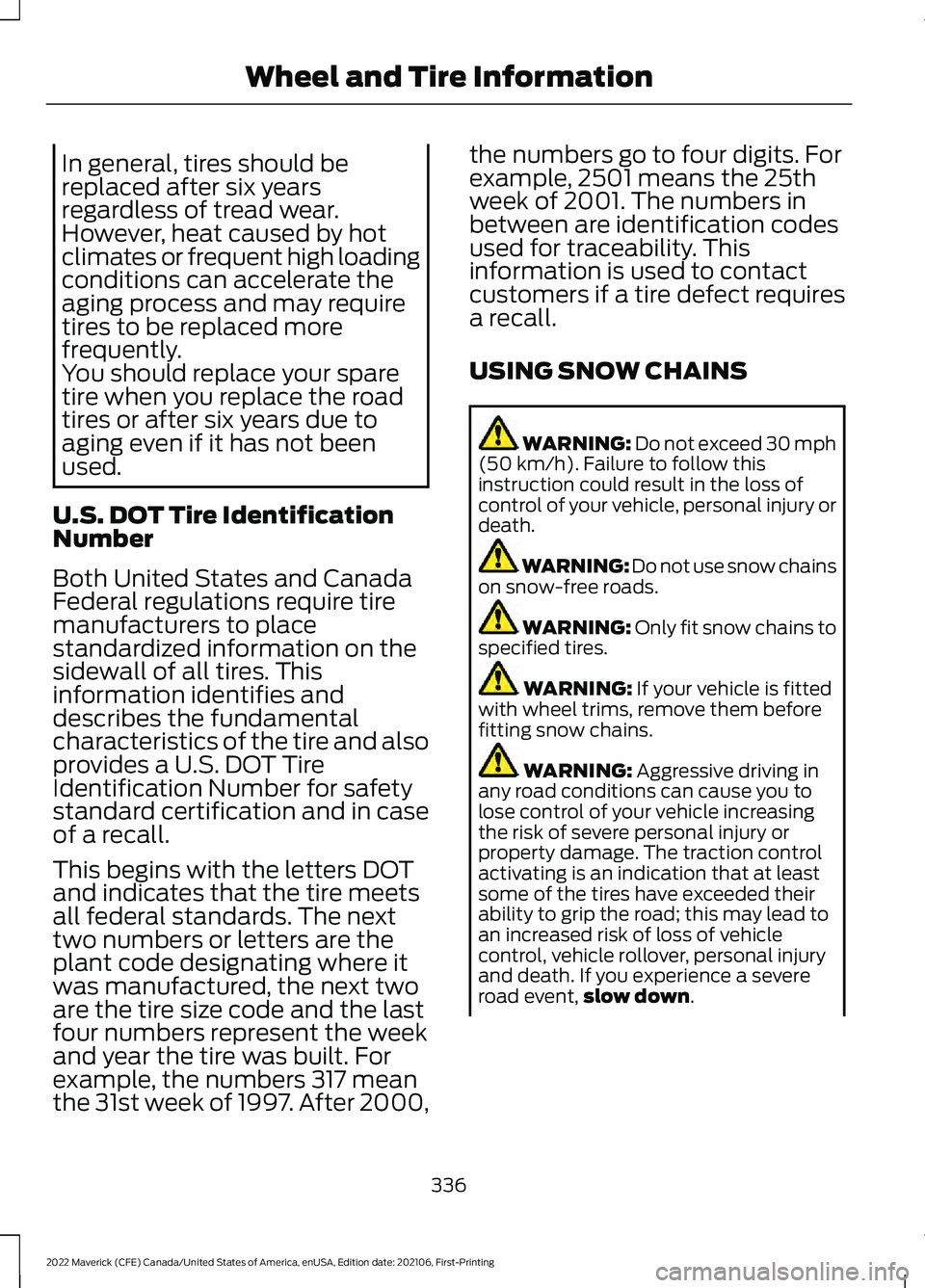
In general, tires should be
replaced after six years
regardless of tread wear.
However, heat caused by hot
climates or frequent high loading
conditions can accelerate the
aging process and may require
tires to be replaced more
frequently.
You should replace your spare
tire when you replace the road
tires or after six years due to
aging even if it has not been
used.
U.S. DOT Tire Identification
Number
Both United States and Canada
Federal regulations require tire
manufacturers to place
standardized information on the
sidewall of all tires. This
information identifies and
describes the fundamental
characteristics of the tire and also
provides a U.S. DOT Tire
Identification Number for safety
standard certification and in case
of a recall.
This begins with the letters DOT
and indicates that the tire meets
all federal standards. The next
two numbers or letters are the
plant code designating where it
was manufactured, the next two
are the tire size code and the last
four numbers represent the week
and year the tire was built. For
example, the numbers 317 mean
the 31st week of 1997. After 2000, the numbers go to four digits. For
example, 2501 means the 25th
week of 2001. The numbers in
between are identification codes
used for traceability. This
information is used to contact
customers if a tire defect requires
a recall.
USING SNOW CHAINS
WARNING: Do not exceed 30 mph
(50 km/h). Failure to follow this
instruction could result in the loss of
control of your vehicle, personal injury or
death. WARNING:
Do not use snow chains
on snow-free roads. WARNING:
Only fit snow chains to
specified tires. WARNING:
If your vehicle is fitted
with wheel trims, remove them before
fitting snow chains. WARNING:
Aggressive driving in
any road conditions can cause you to
lose control of your vehicle increasing
the risk of severe personal injury or
property damage. The traction control
activating is an indication that at least
some of the tires have exceeded their
ability to grip the road; this may lead to
an increased risk of loss of vehicle
control, vehicle rollover, personal injury
and death. If you experience a severe
road event, slow down
.
336
2022 Maverick (CFE) Canada/United States of America, enUSA, Edition date: 202106, First-Printing Wheel and Tire Information
Page 340 of 533
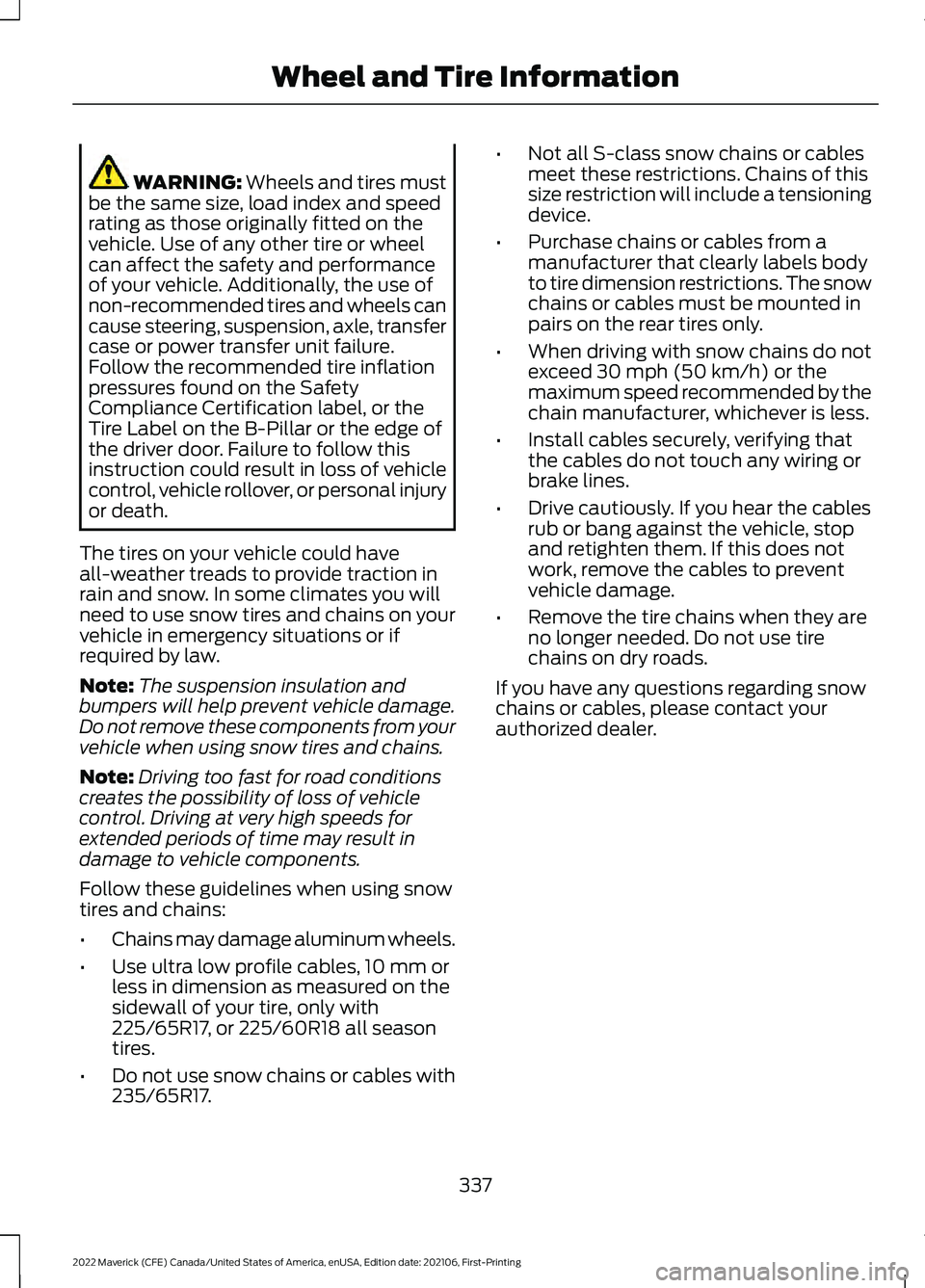
WARNING: Wheels and tires must
be the same size, load index and speed
rating as those originally fitted on the
vehicle. Use of any other tire or wheel
can affect the safety and performance
of your vehicle. Additionally, the use of
non-recommended tires and wheels can
cause steering, suspension, axle, transfer
case or power transfer unit failure.
Follow the recommended tire inflation
pressures found on the Safety
Compliance Certification label, or the
Tire Label on the B-Pillar or the edge of
the driver door. Failure to follow this
instruction could result in loss of vehicle
control, vehicle rollover, or personal injury
or death.
The tires on your vehicle could have
all-weather treads to provide traction in
rain and snow. In some climates you will
need to use snow tires and chains on your
vehicle in emergency situations or if
required by law.
Note: The suspension insulation and
bumpers will help prevent vehicle damage.
Do not remove these components from your
vehicle when using snow tires and chains.
Note: Driving too fast for road conditions
creates the possibility of loss of vehicle
control. Driving at very high speeds for
extended periods of time may result in
damage to vehicle components.
Follow these guidelines when using snow
tires and chains:
• Chains may damage aluminum wheels.
• Use ultra low profile cables, 10 mm or
less in dimension as measured on the
sidewall of your tire, only with
225/65R17, or 225/60R18 all season
tires.
• Do not use snow chains or cables with
235/65R17. •
Not all S-class snow chains or cables
meet these restrictions. Chains of this
size restriction will include a tensioning
device.
• Purchase chains or cables from a
manufacturer that clearly labels body
to tire dimension restrictions. The snow
chains or cables must be mounted in
pairs on the rear tires only.
• When driving with snow chains do not
exceed
30 mph (50 km/h) or the
maximum speed recommended by the
chain manufacturer, whichever is less.
• Install cables securely, verifying that
the cables do not touch any wiring or
brake lines.
• Drive cautiously. If you hear the cables
rub or bang against the vehicle, stop
and retighten them. If this does not
work, remove the cables to prevent
vehicle damage.
• Remove the tire chains when they are
no longer needed. Do not use tire
chains on dry roads.
If you have any questions regarding snow
chains or cables, please contact your
authorized dealer.
337
2022 Maverick (CFE) Canada/United States of America, enUSA, Edition date: 202106, First-Printing Wheel and Tire Information
Page 448 of 533
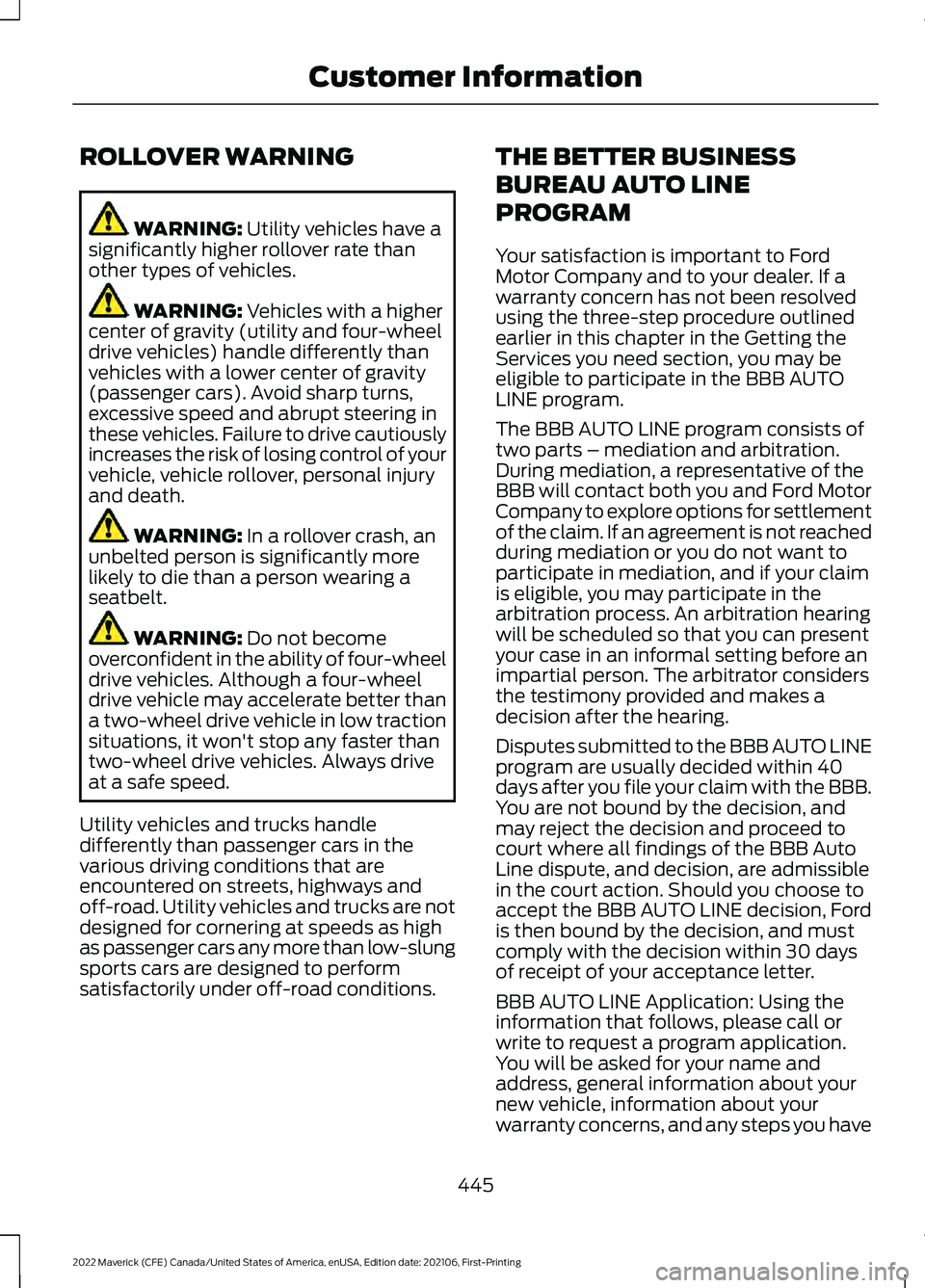
ROLLOVER WARNING
WARNING: Utility vehicles have a
significantly higher rollover rate than
other types of vehicles. WARNING:
Vehicles with a higher
center of gravity (utility and four-wheel
drive vehicles) handle differently than
vehicles with a lower center of gravity
(passenger cars). Avoid sharp turns,
excessive speed and abrupt steering in
these vehicles. Failure to drive cautiously
increases the risk of losing control of your
vehicle, vehicle rollover, personal injury
and death. WARNING:
In a rollover crash, an
unbelted person is significantly more
likely to die than a person wearing a
seatbelt. WARNING:
Do not become
overconfident in the ability of four-wheel
drive vehicles. Although a four-wheel
drive vehicle may accelerate better than
a two-wheel drive vehicle in low traction
situations, it won't stop any faster than
two-wheel drive vehicles. Always drive
at a safe speed.
Utility vehicles and trucks handle
differently than passenger cars in the
various driving conditions that are
encountered on streets, highways and
off-road. Utility vehicles and trucks are not
designed for cornering at speeds as high
as passenger cars any more than low-slung
sports cars are designed to perform
satisfactorily under off-road conditions. THE BETTER BUSINESS
BUREAU AUTO LINE
PROGRAM
Your satisfaction is important to Ford
Motor Company and to your dealer. If a
warranty concern has not been resolved
using the three-step procedure outlined
earlier in this chapter in the Getting the
Services you need section, you may be
eligible to participate in the BBB AUTO
LINE program.
The BBB AUTO LINE program consists of
two parts – mediation and arbitration.
During mediation, a representative of the
BBB will contact both you and Ford Motor
Company to explore options for settlement
of the claim. If an agreement is not reached
during mediation or you do not want to
participate in mediation, and if your claim
is eligible, you may participate in the
arbitration process. An arbitration hearing
will be scheduled so that you can present
your case in an informal setting before an
impartial person. The arbitrator considers
the testimony provided and makes a
decision after the hearing.
Disputes submitted to the BBB AUTO LINE
program are usually decided within 40
days after you file your claim with the BBB.
You are not bound by the decision, and
may reject the decision and proceed to
court where all findings of the BBB Auto
Line dispute, and decision, are admissible
in the court action. Should you choose to
accept the BBB AUTO LINE decision, Ford
is then bound by the decision, and must
comply with the decision within 30 days
of receipt of your acceptance letter.
BBB AUTO LINE Application: Using the
information that follows, please call or
write to request a program application.
You will be asked for your name and
address, general information about your
new vehicle, information about your
warranty concerns, and any steps you have
445
2022 Maverick (CFE) Canada/United States of America, enUSA, Edition date: 202106, First-Printing Customer Information
Page 489 of 533
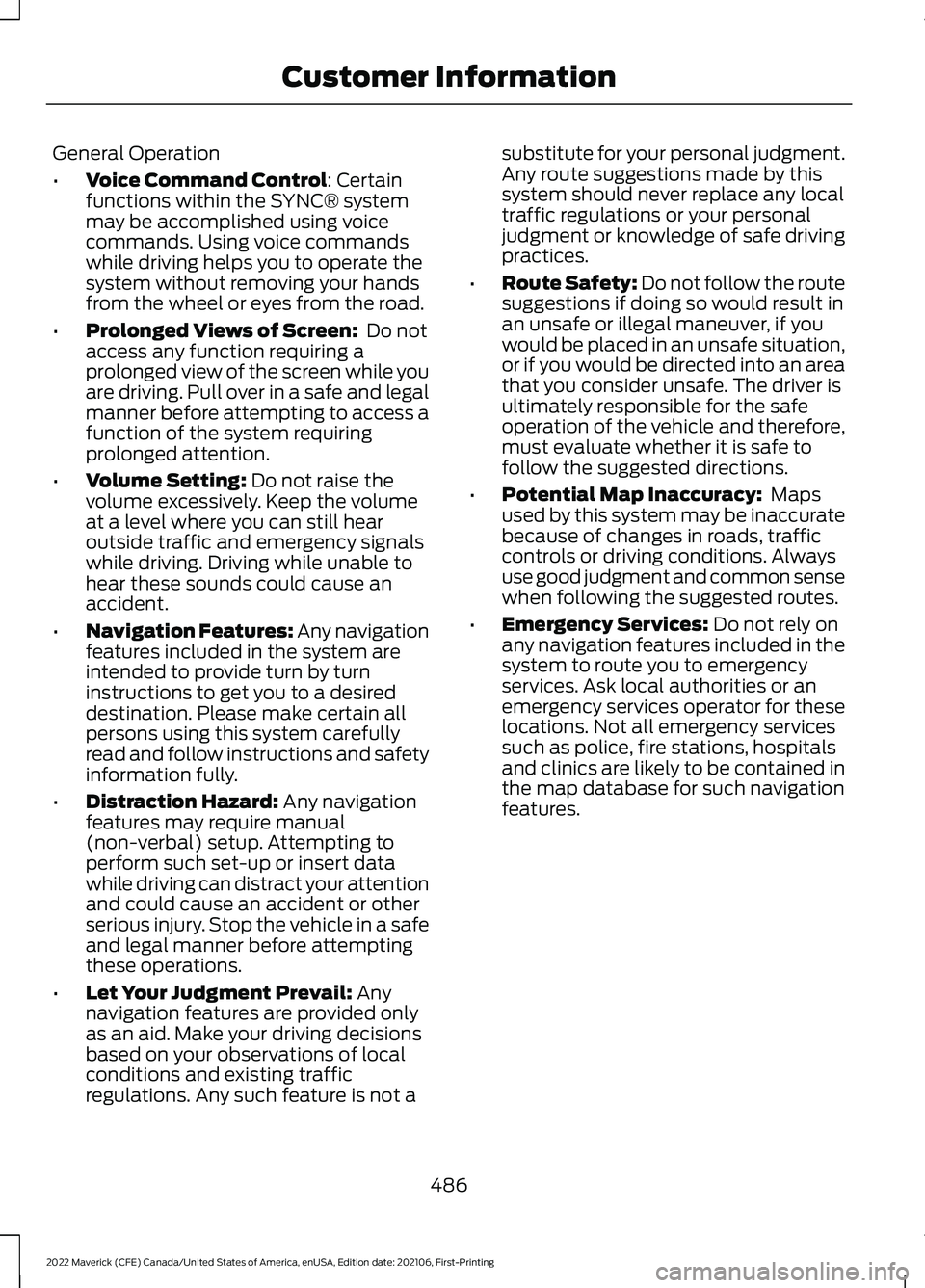
General Operation
•
Voice Command Control: Certain
functions within the SYNC® system
may be accomplished using voice
commands. Using voice commands
while driving helps you to operate the
system without removing your hands
from the wheel or eyes from the road.
• Prolonged Views of Screen:
Do not
access any function requiring a
prolonged view of the screen while you
are driving. Pull over in a safe and legal
manner before attempting to access a
function of the system requiring
prolonged attention.
• Volume Setting:
Do not raise the
volume excessively. Keep the volume
at a level where you can still hear
outside traffic and emergency signals
while driving. Driving while unable to
hear these sounds could cause an
accident.
• Navigation Features:
Any navigation
features included in the system are
intended to provide turn by turn
instructions to get you to a desired
destination. Please make certain all
persons using this system carefully
read and follow instructions and safety
information fully.
• Distraction Hazard:
Any navigation
features may require manual
(non-verbal) setup. Attempting to
perform such set-up or insert data
while driving can distract your attention
and could cause an accident or other
serious injury. Stop the vehicle in a safe
and legal manner before attempting
these operations.
• Let Your Judgment Prevail:
Any
navigation features are provided only
as an aid. Make your driving decisions
based on your observations of local
conditions and existing traffic
regulations. Any such feature is not a substitute for your personal judgment.
Any route suggestions made by this
system should never replace any local
traffic regulations or your personal
judgment or knowledge of safe driving
practices.
• Route Safety: Do not follow the route
suggestions if doing so would result in
an unsafe or illegal maneuver, if you
would be placed in an unsafe situation,
or if you would be directed into an area
that you consider unsafe. The driver is
ultimately responsible for the safe
operation of the vehicle and therefore,
must evaluate whether it is safe to
follow the suggested directions.
• Potential Map Inaccuracy:
Maps
used by this system may be inaccurate
because of changes in roads, traffic
controls or driving conditions. Always
use good judgment and common sense
when following the suggested routes.
• Emergency Services:
Do not rely on
any navigation features included in the
system to route you to emergency
services. Ask local authorities or an
emergency services operator for these
locations. Not all emergency services
such as police, fire stations, hospitals
and clinics are likely to be contained in
the map database for such navigation
features.
486
2022 Maverick (CFE) Canada/United States of America, enUSA, Edition date: 202106, First-Printing Customer Information
Page 523 of 533
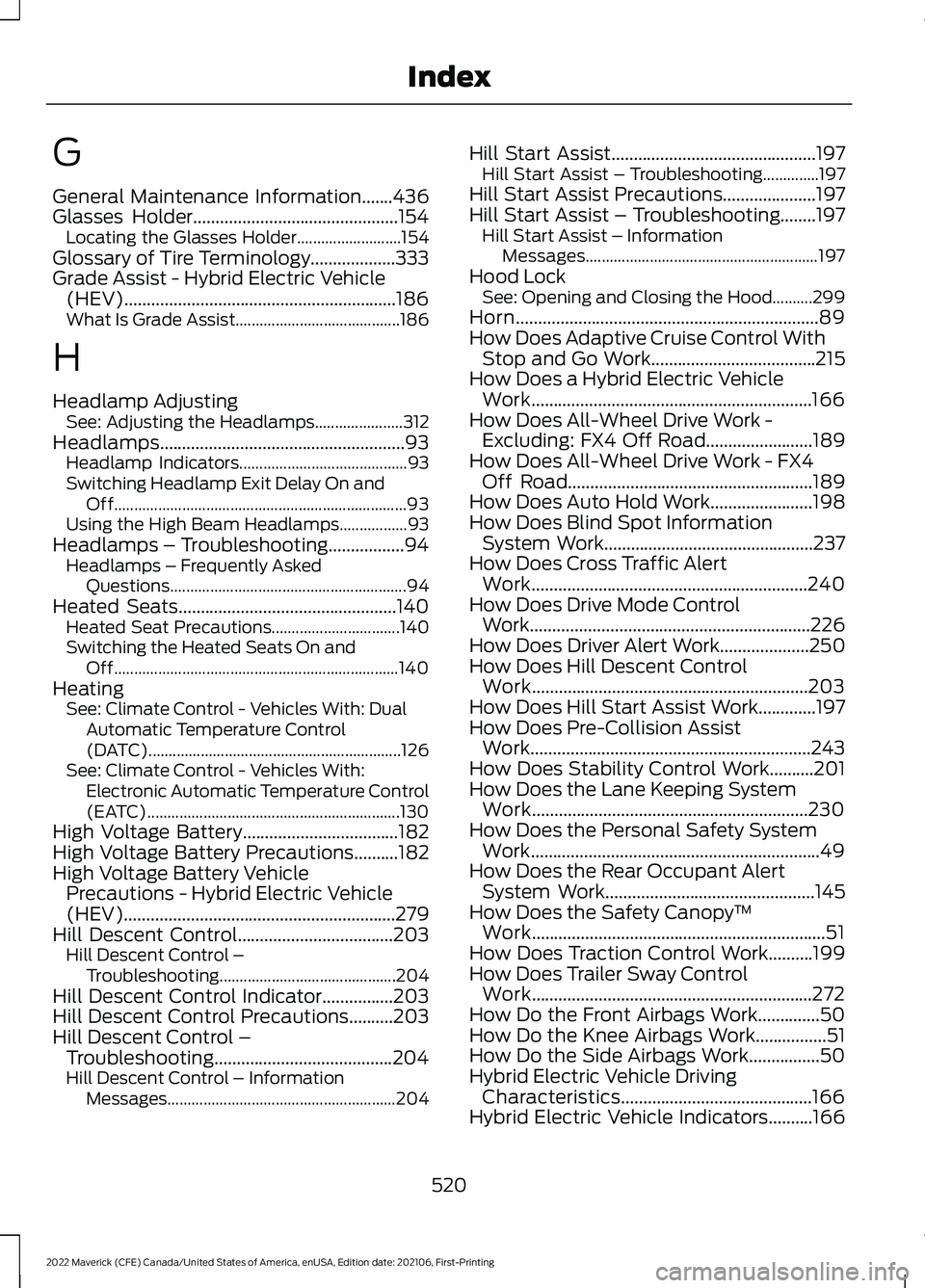
G
General Maintenance Information.......436
Glasses Holder..............................................154
Locating the Glasses Holder.......................... 154
Glossary of Tire Terminology...................333
Grade Assist - Hybrid Electric Vehicle (HEV).............................................................186
What Is Grade Assist......................................... 186
H
Headlamp Adjusting See: Adjusting the Headlamps...................... 312
Headlamps.......................................................93 Headlamp Indicators.......................................... 93
Switching Headlamp Exit Delay On and Off........................................................................\
. 93
Using the High Beam Headlamps.................93
Headlamps – Troubleshooting.................94
Headlamps – Frequently Asked
Questions........................................................... 94
Heated Seats
.................................................140
Heated Seat Precautions................................ 140
Switching the Heated Seats On and Off....................................................................... 140
Heating See: Climate Control - Vehicles With: Dual
Automatic Temperature Control
(DATC)............................................................... 126
See: Climate Control - Vehicles With: Electronic Automatic Temperature Control
(EATC)............................................................... 130
High Voltage Battery...................................182
High Voltage Battery Precautions..........182
High Voltage Battery Vehicle Precautions - Hybrid Electric Vehicle
(HEV).............................................................279
Hill Descent Control
...................................203
Hill Descent Control –
Troubleshooting............................................ 204
Hill Descent Control Indicator................203
Hill Descent Control Precautions..........203
Hill Descent Control – Troubleshooting
........................................204
Hill Descent Control – Information
Messages......................................................... 204Hill Start Assist..............................................197
Hill Start Assist – Troubleshooting..............197
Hill Start Assist Precautions.....................197
Hill Start Assist – Troubleshooting........197 Hill Start Assist – Information
Messages.......................................................... 197
Hood Lock See: Opening and Closing the Hood..........299
Horn
....................................................................89
How Does Adaptive Cruise Control With Stop and Go Work.....................................215
How Does a Hybrid Electric Vehicle Work...............................................................166
How Does All-Wheel Drive Work - Excluding: FX4 Off Road........................189
How Does All-Wheel Drive Work - FX4 Off Road
.......................................................189
How Does Auto Hold Work.......................198
How Does Blind Spot Information System Work
...............................................237
How Does Cross Traffic Alert Work..............................................................240
How Does Drive Mode Control Work
...............................................................226
How Does Driver Alert Work....................250
How Does Hill Descent Control Work..............................................................203
How Does Hill Start Assist Work.............197
How Does Pre-Collision Assist Work...............................................................243
How Does Stability Control Work..........201
How Does the Lane Keeping System Work..............................................................230
How Does the Personal Safety System Work.................................................................49
How Does the Rear Occupant Alert System Work
...............................................145
How Does the Safety Canopy ™
Work..................................................................51
How Does Traction Control Work..........199
How Does Trailer Sway Control Work...............................................................272
How Do the Front Airbags Work..............50
How Do the Knee Airbags Work................51
How Do the Side Airbags Work................50
Hybrid Electric Vehicle Driving Characteristics
...........................................166
Hybrid Electric Vehicle Indicators..........166
520
2022 Maverick (CFE) Canada/United States of America, enUSA, Edition date: 202106, First-Printing Index
Page 530 of 533
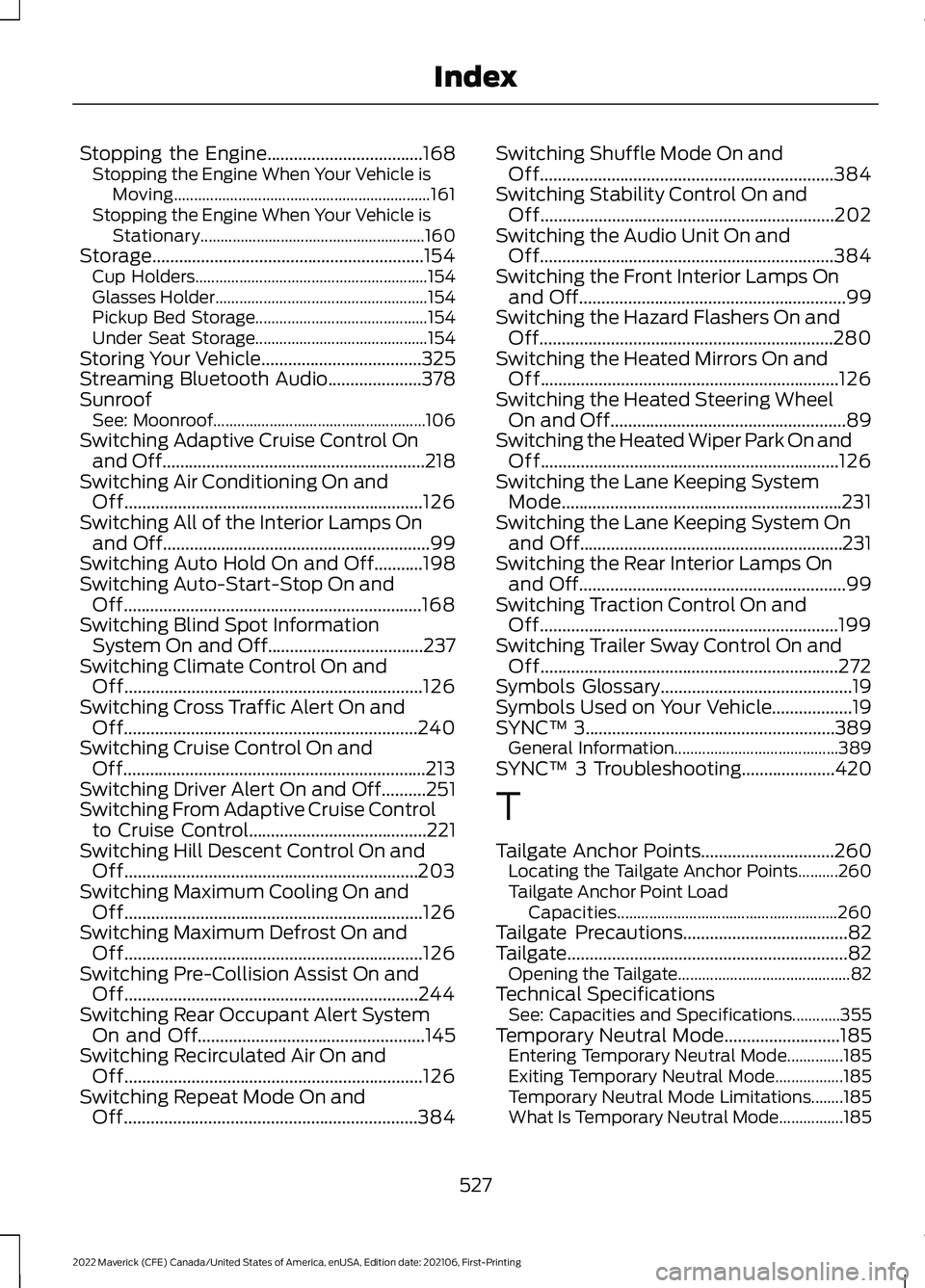
Stopping the Engine...................................168
Stopping the Engine When Your Vehicle is
Moving................................................................ 161
Stopping the Engine When Your Vehicle is Stationary........................................................ 160
Storage.............................................................154 Cup Holders.......................................................... 154
Glasses Holder..................................................... 154
Pickup Bed Storage........................................... 154
Under Seat Storage........................................... 154
Storing Your Vehicle....................................325
Streaming Bluetooth Audio.....................378
Sunroof See: Moonroof..................................................... 106
Switching Adaptive Cruise Control On and Off
...........................................................218
Switching Air Conditioning On and Off...................................................................126
Switching All of the Interior Lamps On and Off
............................................................99
Switching Auto Hold On and Off...........198
Switching Auto-Start-Stop On and Off...................................................................168
Switching Blind Spot Information System On and Off
...................................237
Switching Climate Control On and Off...................................................................126
Switching Cross Traffic Alert On and Off
..................................................................240
Switching Cruise Control On and Off....................................................................213
Switching Driver Alert On and Off
..........251
Switching From Adaptive Cruise Control to Cruise Control
........................................221
Switching Hill Descent Control On and Off..................................................................203
Switching Maximum Cooling On and Off...................................................................126
Switching Maximum Defrost On and Off...................................................................126
Switching Pre-Collision Assist On and Off..................................................................244
Switching Rear Occupant Alert System On and Off
...................................................145
Switching Recirculated Air On and Off...................................................................126
Switching Repeat Mode On and Off..................................................................384 Switching Shuffle Mode On and
Off..................................................................384
Switching Stability Control On and Off..................................................................202
Switching the Audio Unit On and Off..................................................................384
Switching the Front Interior Lamps On and Off
............................................................99
Switching the Hazard Flashers On and Off..................................................................280
Switching the Heated Mirrors On and Off...................................................................126
Switching the Heated Steering Wheel On and Off
.....................................................89
Switching the Heated Wiper Park On and Off...................................................................126
Switching the Lane Keeping System Mode...............................................................231
Switching the Lane Keeping System On and Off...........................................................231
Switching the Rear Interior Lamps On and Off
............................................................99
Switching Traction Control On and Off
...................................................................199
Switching Trailer Sway Control On and Off
...................................................................272
Symbols Glossary...........................................19
Symbols Used on Your Vehicle..................19
SYNC™ 3........................................................389
General Information......................................... 389
SYNC™ 3 Troubleshooting.....................420
T
Tailgate Anchor Points..............................260 Locating the Tailgate Anchor Points..........260
Tailgate Anchor Point Load
Capacities....................................................... 260
Tailgate Precautions
.....................................82
Tailgate...............................................................82 Opening the Tailgate........................................... 82
Technical Specifications See: Capacities and Specifications............355
Temporary Neutral Mode
..........................185
Entering Temporary Neutral Mode..............185
Exiting Temporary Neutral Mode.................185
Temporary Neutral Mode Limitations........185
What Is Temporary Neutral Mode................185
527
2022 Maverick (CFE) Canada/United States of America, enUSA, Edition date: 202106, First-Printing Index